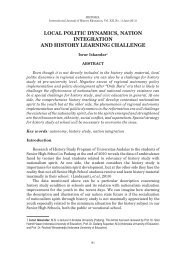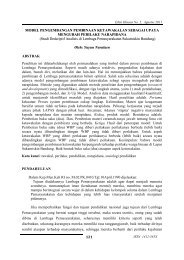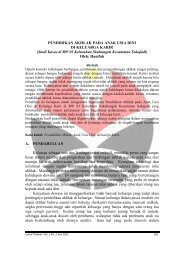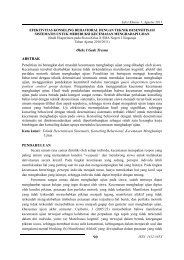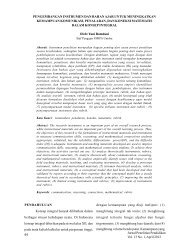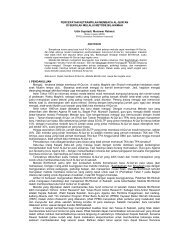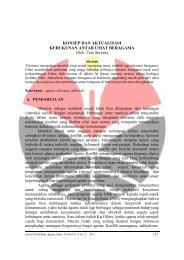a descriptive study on the teacher talk at eyl classroom - Jurnal UPI
a descriptive study on the teacher talk at eyl classroom - Jurnal UPI
a descriptive study on the teacher talk at eyl classroom - Jurnal UPI
Create successful ePaper yourself
Turn your PDF publications into a flip-book with our unique Google optimized e-Paper software.
CONAPLIN JOURNAL<br />
Ind<strong>on</strong>esian Journal of Applied Linguistics, Vol. 1 No. 2 (January 2012)<br />
@The Author(s) 2012<br />
Never<strong>the</strong>less, <strong>the</strong> findings obtained so far haven‟t really revealed <strong>the</strong> phenomena of <strong>the</strong><br />
importance and effectiveness of <strong>teacher</strong> <strong>talk</strong>. Thus, this <str<strong>on</strong>g>study</str<strong>on</strong>g> <strong>at</strong>tempts to answer <strong>the</strong><br />
following questi<strong>on</strong>s: (1) Wh<strong>at</strong> is <strong>the</strong> amount of TTT ( <strong>teacher</strong> Talk Time) used by <strong>the</strong> <strong>teacher</strong>s<br />
in <strong>classroom</strong> settings?, (2) Wh<strong>at</strong> is <strong>the</strong> students‟ percepti<strong>on</strong> towards <strong>the</strong> amount of TTT<br />
(Teacher Talk Time) used by EFL <strong>teacher</strong>s in <strong>the</strong> process of teaching and learning?, (3) Wh<strong>at</strong><br />
are <strong>the</strong> TT ( Teacher Talk) fe<strong>at</strong>ures comm<strong>on</strong>ly used by EFL <strong>teacher</strong>s in <strong>the</strong> process of teaching<br />
and learning?, (4) Wh<strong>at</strong>‟s <strong>the</strong> frequency of display questi<strong>on</strong>s and referential questi<strong>on</strong>s used by<br />
<strong>teacher</strong>s in <strong>classroom</strong> activity?, and (5) Wh<strong>at</strong>‟s <strong>the</strong> frequency of different types of <strong>teacher</strong>‟s<br />
assessment? In wh<strong>at</strong> ways will <strong>teacher</strong>s give feedback to students when <strong>the</strong> errors occur during<br />
<strong>the</strong> teaching-learning process? Some fundamental <strong>the</strong>ories are taken as <strong>the</strong> basic of this <str<strong>on</strong>g>study</str<strong>on</strong>g>.<br />
The Role of TT in Foreign Language Learning<br />
„If <strong>the</strong> sec<strong>on</strong>d language is learnt as a foreign language in a language class in a n<strong>on</strong>-supportive<br />
envir<strong>on</strong>ment, like in Ind<strong>on</strong>esia , instructi<strong>on</strong> (<strong>teacher</strong> <strong>talk</strong>) is likely to be <strong>the</strong> major or even <strong>the</strong><br />
<strong>on</strong>ly source of target language input‟ (Stern, 1983 p. 400). Krashen with his SLA <strong>the</strong>ory says<br />
TT determines successful language learning by providing plenty of and high quality input for<br />
(1985 p. 78). Nunan (1991) also points out: Teacher <strong>talk</strong> is a crucial of importance, not <strong>on</strong>ly<br />
for <strong>the</strong> organiz<strong>at</strong>i<strong>on</strong> of <strong>the</strong> <strong>classroom</strong> but also for <strong>the</strong> process of acquisiti<strong>on</strong>. It is through<br />
language th<strong>at</strong> <strong>teacher</strong>s ei<strong>the</strong>r succeed or fail in implementing <strong>the</strong>ir plans. In terms of<br />
acquisiti<strong>on</strong>, <strong>teacher</strong> <strong>talk</strong> is important because it is probably <strong>the</strong> major source of<br />
comprehensible target language input <strong>the</strong> learner is likely to receive.<br />
Yet, to determine wh<strong>at</strong> <strong>the</strong> best and <strong>the</strong> most effective <strong>teacher</strong> <strong>talk</strong> is like is not easy since<br />
every <strong>teacher</strong> brings <strong>the</strong>ir certain characteristics which are influenced by different age, sex,<br />
previous educ<strong>at</strong>i<strong>on</strong>, and pers<strong>on</strong>al qualities. Above all, <strong>teacher</strong>s also bring <strong>the</strong>ir language<br />
background and experience, professi<strong>on</strong>al training as a linguist and <strong>teacher</strong>, previous language<br />
teaching experience, and more or less formul<strong>at</strong>ed <strong>the</strong>oretical presuppositi<strong>on</strong>s about language,<br />
language learning and teaching‟ (Stern, 1983 p. 500).<br />
L<strong>on</strong>g and S<strong>at</strong>o (1983) observed all kinds of phenomena about <strong>teacher</strong> <strong>talk</strong>, and made some<br />
comparis<strong>on</strong>s between <strong>the</strong> language <strong>teacher</strong>s use in and out of language <strong>classroom</strong>s. Their main<br />
findings are as follows:<br />
1. Formal adjustments occur <strong>at</strong> all language levels – in pr<strong>on</strong>unci<strong>at</strong>i<strong>on</strong>, lexis and grammar.<br />
2. In general, ungramm<strong>at</strong>ical speech modific<strong>at</strong>i<strong>on</strong>s do not occur.<br />
3. Interacti<strong>on</strong>al adjustments occur. (Ellis, 1985 p. 145)<br />
Besides, <strong>teacher</strong> <strong>talk</strong> is simplified in o<strong>the</strong>r ways – syntactically, ph<strong>on</strong>ologically and<br />
semantically. Chaudr<strong>on</strong> (1988 p. 85), proposed <strong>teacher</strong> <strong>talk</strong> in language <strong>classroom</strong>s with his<br />
seven modific<strong>at</strong>i<strong>on</strong>s: 1) R<strong>at</strong>e of speech appears to be slower; 2) Pauses, which may be<br />
evidence of <strong>the</strong> speaker planning more, are possibly more frequent and l<strong>on</strong>ger; 3)<br />
Pr<strong>on</strong>unci<strong>at</strong>i<strong>on</strong> tends to be exagger<strong>at</strong>ed and simplified ; 4)Vocabulary use is more basic; 5)<br />
Degree of subordin<strong>at</strong>i<strong>on</strong> is slower ; 6) More declar<strong>at</strong>ives and st<strong>at</strong>ements are used than<br />
questi<strong>on</strong>s; 7)Teachers may self-repe<strong>at</strong> more frequently.<br />
35 | P a g e



